Lanzhou–Xinjiang railway
| Lanzhou−Xinjiang railway 兰新铁路 | |
|---|---|
 A train running through the deserts of Xinjiang | |
| Overview | |
| Status | Operational |
| Locale | |
| Termini | Lanzhou railway station Ürümqi South railway station |
| Service | |
| Type | Heavy rail |
| System | |
| Operator(s) | China Railway Lanzhou Group China Railway Ürümqi Group |
| History | |
| Opened | 1966 |
| Technical | |
| Line length | 1,904 km (1,183 mi) |
| Number of tracks | 2 (Double-track railway) |
| Track gauge | 1,435 mm (4 ft 8+1⁄2 in) standard gauge |
| Operating speed | 160km/h |
The Lanzhou−Xinjiang railway or Lanxin railway (simplified Chinese: 兰新铁路; traditional Chinese: 蘭新鐵路; pinyin: Lánxīn Tiělù), is the longest railway in Northwestern China. It runs 1904 kilometres (1,183 miles) from Lanzhou, Gansu, through the Hexi Corridor, to Ürümqi, in Xinjiang. It was Xinjiang's only rail link with the rest of China until the opening of the Lanzhou–Xinjiang high-speed railway in December 2014. The railway follows the path of the ancient Silk Road.
History[]
The Lanzhou–Xinjiang railway, often abbreviated as the Lanxin line, is the longest railway built by the People's Republic of China. It was built by the China Railway Engineering Corporation. Construction of the initial stage (to Ürümqi) started in 1952, completed in 1962 and opened in 1966. The extension to the Kazakhstan border was built in the late 1980s, linkup with the Kazakhstan Railroads achieved on September 12, 1990. After the completion of the 20 km Wushaoling Tunnel in 2006, the railway from Lanzhou to Ürümqi is all double-tracked.
Route[]

The Lanxin railway's eastern terminus is Lanzhou railway station. Lanzhou is a railway junction city in eastern Gansu Province, where the Lanzhou–Qinghai, Baotou–Lanzhou and Longhai Railways converge. From Lanzhou, the line heads west, across the Yellow River, into the Hexi Corridor, where it passes through Gansu cities Wuwei, Jinchang, Zhangye, Jiuquan and Jiayuguan, en route to Xinjiang. Once in Xinjiang, the railway passes through Hami, Shanshan, Turpan and Dabancheng, before reaching Ürümqi in central Xinjiang.
The Lanxin railway is sometimes categorized to include the Northern Xinjiang railway, which continues west from Ürümqi to Alashankou, on the Kazakhstan border. The distance from Alashankou to Lanzhou is 2360 km. Beyond Alashankou, the railway links up with the Turkestan–Siberia railway of Central Asia and eventually reaches Rotterdam.
Station list[]
| Station | Chinese | Distance (km2) | Location | |
|---|---|---|---|---|
| Lanzhou Longhai railway Baotou–Lanzhou railway |
兰州 | 0 | Lanzhou | Gansu |
| Lanzhou West | 兰州西 | Lanzhou | Gansu | |
| Stations in between 陈官营 - 西固城 - 坡底下 - 河口南 Lanzhou–Qinghai railway | ||||
| 武威南 | 290 | Wuwei | Gansu | |
| 武威 | 303 | Wuwei | Gansu | |
| Stations in between 北河 - 槐安 - 截河坝 - 青山堡 - 宗家庄 | ||||
| 金昌 | 377 | Jinchang | Gansu | |
| Stations in between 东大山 - 玉石 - 芨岭 - 尖山 - 大青田口 | ||||
| Zhangye | 张掖 | 547 | Zhangye | Gansu |
| Stations in between 乌江堡 - 平原堡 - 临泽 - 新华庄 - 高台 | ||||
| Qingshui | 清水 | 684 | Jiuquan | Gansu |
| Stations in between 丰乐滩 - 上河清 - 金佛寺 - 红山堡 | ||||
|
|
酒泉 | 748 | Jiuquan | Gansu |
Jiayuguan–Jingtieshan Railway Jiayuguan–Ceke Railway |
嘉峪关 | 770 | Jiayuguan | Gansu |
| Stations in between 大草滩 - 黑山湖 - 玉门 - 新民堡 - 鄯马河 | ||||
| 低窝铺 | 880 | Jiuquan | Gansu | |
| Stations in between 玉门镇 - 军垦 | ||||
| 疏勒河 | 925 | Jiuquan | Gansu | |
| Stations in between 疏勒河 - 河东 - 桥湾 - 柳沟 Dunhuang Railway - 安北 | ||||
| 柳园 | 1067 | Jiuquan | Gansu | |
| 小泉东 | 1083 | Jiuquan | Gansu | |
| 大泉 | 1104 | Jiuquan | Gansu | |
| 照东 | 1126 | Jiuquan | Gansu | |
| 红柳��� | 1153 | Jiuquan | Gansu | |
| 天湖 | 1176 | Hami | Xinjiang | |
| 尾亚 | 1197 | Hami | Xinjiang | |
| 思甜 | 1219 | Hami | Xinjiang | |
| 山��� | 1242 | Hami | Xinjiang | |
| 烟墩 | 1262 | Hami | Xinjiang | |
| 盐泉 | 1287 | Hami | Xinjiang | |
| 红旗村 | 1301 | Hami | Xinjiang | |
| Hongguang | 红光 | 1328 | Hami | Xinjiang |
| Hami | 哈密 | 1339 | Hami | Xinjiang |
| 火石泉 | 1352 | Hami | Xinjiang | |
| 头堡 | 1368 | Hami | Xinjiang | |
| 二堡 | 1384 | Hami | Xinjiang | |
| 柳树泉 | 1398 | Hami | Xinjiang | |
| 雅子泉 | 1426 | Hami | Xinjiang | |
| 了墩 | 1455 | Hami | Xinjiang | |
| 十三间房 | 1496 | Hami | Xinjiang | |
| Station in between 大步 | ||||
| 鄯善 | 1609 | Turpan | Xinjiang | |
| 七泉湖 | 1696 | Turpan | Xinjiang | |
| 煤窑沟 | 1708 | Turpan | Xinjiang | |
| Station in between 夏普吐勒 | ||||
| Turpan Southern Xinjiang Railway |
吐鲁番 | 1749 | Turpan | Xinjiang |
| Station in between 天山 | ||||
| 达板桥 | 1802 | Ürümqi | Xinjiang | |
| 盐湖 | 1827 | Ürümqi | Xinjiang | |
| 柴窝堡 | 1841 | Ürümqi | Xinjiang | |
| 三葛庄 | 1859 | Ürümqi | Xinjiang | |
| Station in between 芨芨槽子 | ||||
| 乌拉泊 | 1883 | Ürümqi | Xinjiang | |
| Ürümqi South Northern Xinjiang Railway Second Ürümqi–Jinghe Railway |
乌鲁木齐南 | 1892 | Ürümqi | Xinjiang |
The northern branch[]
The railway's northern branch extends 477 kilometres from Ürümqi to Alataw Pass (its westernmost point), where China's Alashankou railway station is connected to Kazakhstan's Dostyk station.
The southern branch[]
The railway also has a southern branch, which splits off the main line near Turpan (east of Ürümqi), and runs west to Kashgar at the westernmost tip of the country. It was completed in 1999.
Cargo[]
Xinjiang coal is one of the main types of freight shipped along the railway. In 2010, the railway is expected to ship 30 million tons of it, and by 2012, the amount is anticipated to rise to 50 million tons.[1]
Parallel high-speed passenger rail line[]
A new high-speed passenger rail line from Lanzhou to Xinjiang opened in December 2014.[2] The line is mostly parallel to the existing Lanxin railway, with the exception of also serving Xining, Qinghai rather than staying entirely within Gansu province on the way to Xinjiang. The estimated cost was 143.5 billion yuan. Since the completion of this route, the older Lanxin railway is used mostly for freight.[3]
There is also a planned railway connecting Golmud and Korla, to be an alternative railway corridor to Xinjiang.
Gallery[]
- Lanxin Railway
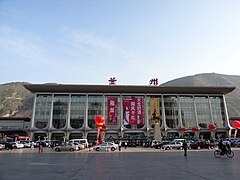
Lanzhou Station
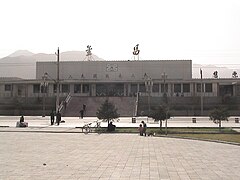
Jinchang Station

Jinchang Station platform
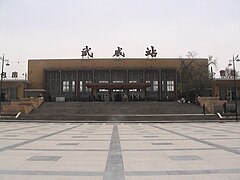
Wuwei Station

Wuwei platform
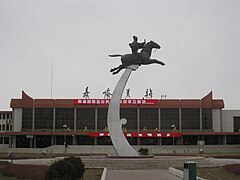
Jiayuguan Station

Liuyuan Station

Wind farm along the railway in Xinjiang
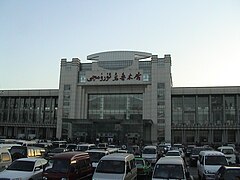
Ürümqi Station
References[]
- "Xinjiang Travel Guide". China Travel Guide. Archived from the original on September 27, 2007. Retrieved December 24, 2005.
- "The Economic Development of Xinjiang After the Founding of New China". Government White Papers. Retrieved December 24, 2005.
- "Lanzhou–Xinjiang Railway". China Railway Engineering Corporation. Archived from the original on March 2, 2006. Retrieved December 24, 2005.
- ^ China Starts Building Second Trunk Railway to Xinjiang, 2010-04-15
- ^ "China extends high-speed rail network to Xinjiang".
- ^ 兰新铁路第二双线今日在乌鲁木齐开工 ("Work on Lanxin's second line starts today at Urumqi") 2009-11-04 (in Chinese)
- Railway lines in China
- Rail transport in Gansu
- Rail transport in Xinjiang
- Railway lines opened in 1962








